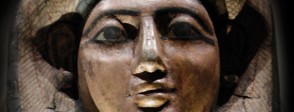Using the information and resources in About the object and For the classroom, compare the reconstruction of Asru’s appearance with the forensic evidence from her mummy and the way she is depicted on her coffins. Identify the main differences and discuss what each of these tells us about her life and beliefs.
With the class, make a life-size collage of Asru’s coffin, including the following which appear from top to bottom on Asru’s inner coffin:
- headdress, mask, collar
- the goddess Nut
- false door and offering inscription
- judgement scene – identify Asru and the gods
- Asru’s mummy and ba with Canopic jars under
- Solar falcons on either side of Asru’s mummy, with wings outstretched to protect it
- Sokar, the falcon-headed cemetery god, shown below Asru’s mummy
- Isis and Nephthys
- Osiris
- sons of Horus
- eye of Horus
Groups of students should research each element and be ready to explain why it is there and how it would help Asru in the next world. Add labels to the collage.
The inscriptions on Asru’s coffins list offerings of things she would need in the afterlife. Have the class look at images of false doors. Typical items shown on these include food and drink, incense, clothes, perfume and makeup. Discuss why these were important to the Egyptians. What would people today want to take to the next world? Ask students to make their own lists of must-haves.
Asru lived much longer than most people of her time; very few Egyptians lived beyond the age of 40. She was also much wealthier than most Egyptians. Today, wealth is still an indicator of longevity; discuss why this might be. Do people living in different countries have different life expectancies? Why?
Discuss how Asru’s medical problems would have made her feel. How many of her ailments are still common today? Students or their family members may have first-hand experiences to share. Using the resources in For the classroom, explore how Egyptian doctors diagnosed and treated different conditions. How might we treat them now?
Because her mummy was already unwrapped, Asru was given a thorough medical examination, but researchers today prefer to use non-invasive methods to find out about a mummy. Give groups of students a variety of objects wrapped in strips of crepe paper, and ask them how they could find out what is inside without unwrapping them. Some students may have undergone x-rays or CT scanning and may like to share their experiences with the class.
Most students will be familiar with forensic techniques from TV crime shows. As part of Asru’s examination, Greater Manchester Police took fingerprints and toeprints. Experiment with fingerprints. It may be possible for the local police to give a demonstration and explain what they can tell us about an individual. Students may also enjoy extracting their own DNA – instructions can be found in the resources in For the classroom.
Explore how Egyptian funerary practice influenced other cultures and how other cultures influenced the Egyptians. Ask groups to compare Asru’s coffin with the mummies and coffins in A bigger picture. What is the same? What is different?
Using the resources in For the classroom, print out a range of Roman mummy portraits. Try to make these as varied as possible – include old and young, male and female and people of different ethnicities. What can each tell us about life in Egypt considering health, wealth, education, fashion, jewellery, hairstyles? Allocate a portrait to each student and ask them to imagine what it was like to be that person and then to write a short autobiography in that role. Students could also make their own Roman style mummy portrait.
Relatives visited the tombs of the dead, and some people wrote letters to deceased family members or kept images of ancestors in the house. The Egyptians also believed the souls of the dead could re-visit their families. If appropriate, you might use images from For the classroom and ask groups to compare how people today remember the dead in different cultural traditions. Are some things we do similar to Egyptian customs?


